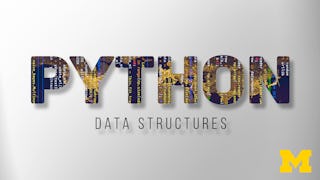In Data Structures for Designers Using Python, you’ll delve into the critical concepts of data structures and object-oriented programming, tailored specifically for design and visual content creation applications. You’ll be introduced to object-oriented programming principles in Python, enabling you to model real-world scenarios and design problems using objects and classes. You will use the Processing platform to draw lines, rectangles, ellipses, and more through the program’s Python mode. Learn about vector math and how it can be manipulated to store, organize, and manage data efficiently in creative projects. These approaches to Python allow you to gain a deeper understanding of the programming language while enhancing your ability to conceptualize and implement sophisticated design solutions.



Data Structures for Designers Using Python
Ce cours fait partie de Spécialisation Programming for Designers

Instructeur : Jose Sanchez
Inclus avec 
Expérience recommandée
Expérience recommandée
Ce que vous apprendrez
Learn to use Python data structures to create intricate designs
Use object-oriented programming to simulate complex behaviors and relationships in design composition
Use Python to create dynamic motions and transformations in digital artwork
Détails à connaître

Ajouter à votre profil LinkedIn
12 devoirs
Découvrez comment les employés des entreprises prestigieuses maîtrisent des compétences recherchées

Élaborez votre expertise du sujet
- Apprenez de nouveaux concepts auprès d'experts du secteur
- Acquérez une compréhension de base d'un sujet ou d'un outil
- Développez des compétences professionnelles avec des projets pratiques
- Obtenez un certificat professionnel partageable


Obtenez un certificat professionnel
Ajoutez cette qualification à votre profil LinkedIn ou à votre CV
Partagez-le sur les réseaux sociaux et dans votre évaluation de performance

Il y a 5 modules dans ce cours
Our journey begins with lists and dictionaries, the fundamental data structures for organizing and storing data in Python. You'll learn how to manipulate these structures using examples that involve typography, exploring how text can be dynamically integrated and manipulated to create engaging visual compositions.
Inclus
18 vidéos10 lectures3 devoirs1 élément d'application1 sujet de discussion
In our second week, we delve into grid structures, learning how to navigate and manipulate grids to perform neighbor operations. This knowledge is crucial for creating complex patterns and interactions within your designs, enabling a deeper exploration of spatial relationships and connectivity.
Inclus
9 vidéos4 lectures2 devoirs1 élément d'application
Vectors and vector math form the backbone of generative art and design. This week focuses on understanding vectors and applying vector math to create dynamic and organic generative drawings. We will explore the power of vectors in modeling motion, forces, and other natural phenomena, translating these concepts into visually stunning designs.
Inclus
9 vidéos4 lectures2 devoirs1 élément d'application
Object-oriented programming (OOP) introduces a new way of thinking about code, focusing on classes and instances. This week, you'll learn how to define classes and create instances, encapsulating both data and functions into objects. This approach will enable you to organize your code more effectively and create more modular and flexible designs.
Inclus
8 vidéos3 lectures3 devoirs1 élément d'application
We conclude our course by expanding our exploration of object-oriented programming. You'll learn how to work with multiple classes and how objects can interact with each other to simulate complex systems. This week provides the groundwork for developing advanced interactive and generative projects, where the interaction between multiple elements creates rich, dynamic systems.
Inclus
10 vidéos5 lectures2 devoirs1 élément d'application
Instructeur

Offert par
Recommandé si vous êtes intéressé(e) par Design and Product


University of Michigan


University of Michigan


University of Michigan


University of Michigan
Pour quelles raisons les étudiants sur Coursera nous choisissent-ils pour leur carrière ?





Ouvrez de nouvelles portes avec Coursera Plus
Accès illimité à 10,000+ cours de niveau international, projets pratiques et programmes de certification prêts à l'emploi - tous inclus dans votre abonnement.
Faites progresser votre carrière avec un diplôme en ligne
Obtenez un diplôme auprès d’universités de renommée mondiale - 100 % en ligne
Rejoignez plus de 3 400 entreprises mondiales qui ont choisi Coursera pour les affaires
Améliorez les compétences de vos employés pour exceller dans l’économie numérique
Foire Aux Questions
Access to lectures and assignments depends on your type of enrollment. If you take a course in audit mode, you will be able to see most course materials for free. To access graded assignments and to earn a Certificate, you will need to purchase the Certificate experience, during or after your audit. If you don't see the audit option:
The course may not offer an audit option. You can try a Free Trial instead, or apply for Financial Aid.
The course may offer 'Full Course, No Certificate' instead. This option lets you see all course materials, submit required assessments, and get a final grade. This also means that you will not be able to purchase a Certificate experience.
When you enroll in the course, you get access to all of the courses in the Specialization, and you earn a certificate when you complete the work. Your electronic Certificate will be added to your Accomplishments page - from there, you can print your Certificate or add it to your LinkedIn profile. If you only want to read and view the course content, you can audit the course for free.
If you subscribed, you get a 7-day free trial during which you can cancel at no penalty. After that, we don’t give refunds, but you can cancel your subscription at any time. See our full refund policy.

